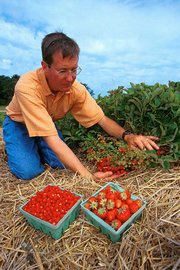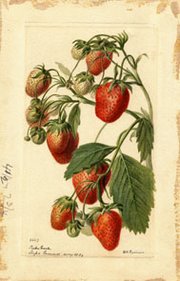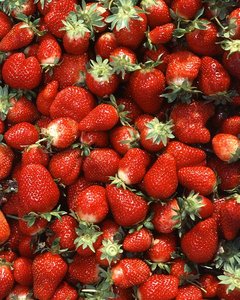| Strawberry | ||||||||||||||
|---|---|---|---|---|---|---|---|---|---|---|---|---|---|---|
'Chandler' strawberries | ||||||||||||||
| Scientific classification | ||||||||||||||
| ||||||||||||||
| Species | ||||||||||||||
| see text |
The strawberry (Fragaria) is a genus of plants in the family Rosaceae (Rose Family), and the fruit of these plants. It is an accessory fruit; that is, the fleshy part is derived not from the ovaries (which are the seeds, actually achenes) but from the peg at the bottom of the hypanthium that held the ovaries. It is greenish-white while it develops and turns red when ripe.
Taxonomy
There are about 12 species, including:
- Fragaria chiloensis (Fragaria chiloesneous in Australia)
- Fragaria daltoniana
- Fragaria moschata
- Fragaria vesca
- Fragaria virginiana
- Fragaria viridis
F. Californica is now generally considered to be F. vesca ssp. californica.
The genus Fragaria consists of about 12 species, native of the temperate regions of the Northern Hemisphere; one species is also found in Chile. The tufted character of the plant, and its habit of sending out long slender branches (runners) which produce a new bud at the extremity, are well known. The leaves have usually three leaflets palmately arranged, but the number of leaflets may be increased to five or reduced to one. While the flower has the typical Rosaceous structure, the fruit is very peculiar, but it may be understood by the contrast it presents with the rose hip of the rose. In roses the top of the flower-stalk expands as it grows into a vase-shaped cavity, the hip, within which are concealed the true fruits or seed-vessels. In the rose the extremity of, the floral axis is concave and bears the carpels in its interior. In the strawberry the floral axis, instead of becoming concave, swells out into a fleshy, dome-shaped or flattened mass in which the carpels or true fruits, commonly called pips or seeds, are more or less embedded but never wholly concealed. A ripe strawberry in fact may be aptly compared to the fruit of a rose turned inside out.
Etymology

The name is derived from Old English streawberige which is a compound of streaw meaning "straw" and berige meaning "berry". The reason for this is unclear. It may derive from the common practice of placing a layer of dry straw on the ground under the developing fruit to protect them from slugs and from being splashed by mud in wet weather, from the strawlike appearance of the runners, or from an obsolete denotation of straw, meaning "chaff", referring to the scattered appearance of the achenes. Interestingly, in other Germanic countries there is a tradition of collecting wild strawberries by threading them on straws.
Cultivation
The common wild strawberry of Great Britain, found throughout Europe and a great part of temperate Asia and North America, is Fragaria vesca. This plant represents the first strawberry species cultivated in the early 17th century. Later, gardeners introduced other species, such as Fragaria elatior, a European species, the parent stock of the Hautbois strawberries, and especially Fragaria virginiana from the United States, and the glamorously large but pulpy and tasteless Fragaria chiloensis first found on the island of Chiloe, off the coast of Chile. From these species, crossed and recrossed in various manners, have sprung the many different strawberry cultivars now listed in catalogues, whose characteristics are so inextricably blended that tracing their lineage has become intractable.
Strawberry varieties vary remarkably in size, colour, flavour, shape, degree of fertility, season of ripening, liability to disease and constitution of plant. Some vary in foliage, others produce no runners, and some vary materially in the relative development of their sexual organs. In most cases the flowers appear hermaphroditic in structure, but function as either male or female. This tendency to dioecism is a common characteristic among the Rosaceae, and sometimes proves a source of disappointment to the cultivator, who finds his plants unexpectedly barren. This happens in the United States more frequently than in Britain, but when recognized can readily be obviated by planting male varieties in the vicinity of the barren kinds.

Charles Darwin, in alluding to the vast variability in the "fruit", a change effected by the art of the horticulturist in less than three centuries, contrasts with this variability the fixity and permanence of character presented by the true fruits, or pips, which are distributed over the surface of the swollen axis. The will and art of the gardener have been directed to the improvement of the one organ, while he has devoted no attention to the other, which consequently remains in the same condition as in the wild plant. Too much stress is not, however, to be laid on this point, for it must be remembered that the foliage, which is not specially an object of the gardener's "selection", nevertheless varies considerably.
The larger-fruited sorts result from crossing from Fragaria chiloensis and Fragaria virginiana, and the smaller alpine strawberries from Fragaria vesca. The alpine varieties should be raised from seeds; while the other sorts are continued true to their kinds by runners. If new varieties are desired, these are obtained by judicious crossing and seeding.
The seeds of the alpines should be saved from the finest fruit ripened early in the summer. They may at once be sown, either in a sheltered border outdoors or in pots, or better in March under glass, when they will produce fruits in June of the same year. The soil should be rich and light, and the seeds very slightly covered by sifting over them some leaf-mould or old decomposed cow dung. When the plants appear and have made five or six leaves, they are transplanted to where they are to remain for bearing. The seeds sown in pots may be helped on by gentle heat, and when the plants are large enough they are pricked out in fine rich soil, and in June transferred to the open ground for bearing; they will produce a partial crop in the autumn, and a full one in the following season. The same treatment may be applied to the choicer seedlings of the larger-fruited sorts from which new varieties are expected. Amongst the best alpine strawberries, to which the name of "perpetual" has now been given, are those known as St Joseph and St Anthony of Padua.
The runners of established sorts should be allowed to root in the soil adjoining the plants, which should, therefore, be kept light and fine, or layered into small pots as for forcing. As soon as a few leaves are produced on each the secondary runners should be stopped. When the plants have become well-rooted they should at once be planted out. They do best in a rather strong loam, and should be kept tolerably moist. The scarlet section prefers a rich sandy loam. The ground should be trenched 50-100 cm deep, and supplied with plenty of manure, a good proportion of which should lie just below the roots, 25-30 cm from the surface. The plants may be put in on an average about 50-60 cm apart.
A mulching of strawy manure put between the rows in spring serves to keep the ground moist and the fruit clean, as well as to afford nourishment to the plants. Unless required, the runners are cut off early, in order to promote the swelling of the fruit. The plants are watered during dry weather after the fruit is set, and occasionally till it begins to colour. As soon as the fruit season is over, the runners are again removed, and the ground hoed and raked.
The plantation should be renewed every second or third year, or less frequently if kept free of runners, if the old leaves are cut away after the fruit has been gathered, and if a good top-dressing of rotten dung or leaf-mould is applied. A top-dressing of loam is beneficial if applied before the plants begin to grow in spring, but after that period they should not be disturbed during the summer either at root or at top. If the plants produce a large number of flower-scapes, each should, if fine large fruit is desired, have them reduced to about four of the strongest. The lowest blossoms on the scape will be found to produce the largest, earliest and best fruits. The fruit should not be gathered till it is quite ripe, and then, if possible, it should be quite dry, but not heated by the sun. Those intended for preserving are best taken without the stalk and the calyx.
Forcing
The runners propagated for forcing are layered into 75 mm pots, filled with rich soil, and held firm by a piece of raffia, a peg or stone. If kept duly watered they will soon form independent plants. The earlier they are secured the better. When firmly rooted they are removed and transferred into well-drained 150 mm pots, of strong well-enriched loam, the soil being rammed firmly into the pots, which are to be set in an open airy place. In severe frosts they should be covered with dry litter or bracken, but do not necessarily require to be placed under glass. They are moved into the forcing houses as required. The main points to be kept in view in forcing strawberries are, first, to have strong stocky plants, the leaves of which have grown sturdily from being well exposed to light, and secondly, to grow them on slowly till fruit is set. When they are first introduced into heat, the temperature should not exceed 8°C to 10°C by fire heat, and air must be freely admitted; should the leaves appear to grow up thin and delicate, less fire heat and more air must be given, but an average temperature of 13°C by day may be allowed and continued while the plants are in flower. When the fruit is set the heat may be gradually increased, till at the ripening period it stands at 18°C to 24°C by sun heat. While the fruit is swelling the plants should never be allowed to get dry, but when it begins to colour no more water should be given than is absolutely requisite to keep the leaves from flagging. The plants should be removed from the house as soon as the crop is gathered. The forced plants properly hardened make first-rate outdoor plantations, and if put out early in summer, in good ground, will often produce a useful autumnal crop.
Diseases
The most troublesome fungoid attacks to which the strawberry is subject are mildew and leaf-spot. The former, like all mildews, attacks the leaves and spreads to the fruit, these being covered with the white mycelium. The fungus is identical with that causing mildew in hops (Sphaerotheca humuli), and its development is greatly furthered by exposure of its host to cold draughts or low night temperatures. Spraying the foliage with potassium sulphide (K2S) (mixed with water at a 1:40 ratio by volume) should hold it in check, but the plants should not be sprayed when the fruit is developing. The "leafspot" is caused by the fungus Sphaerella fragariae. The first symptom of this attack is the appearance of small, circular, white spots on the leaves, having a broad, definite, dark reddish margin.
On these spots a whitish mould (formerly considered to be a distinct species under the name Ramularia tulasnei) develops, and this is followed later by the perfect form of the fungus, the fruits of which appear to the naked eye as small black spots seated on the white dead spot on the leaf. Potassium sulphide may be used as for the mildew, or, perhaps better, Bordeaux mixture. It has been recommended to cut off the leaves after fruiting and turn the beds over so as to destroy the fungus in the leaves.
The grubs of the cockchafer (Meloloniha vulgaris) and the Rose chafer (Cetonia aurata) frequently feed upon the roots of the strawberry and do considerable damage, while the larvae of the Ghost Moth (Hepialus humuli) and garden swift moth behave in a similar way. The imago of Cetonia aurala also frequently damages the flowers of the strawberry by devouring their centres, and is often troublesome in this way in forcing-houses particularly. The carnivorous ground beetles, particularly Pterostichus nigra and Harpalus rufimanus, when the fruit is ripe attack it at night, returning to the soil in the daytime. They are to be caught by placing jars containing some attractive matter, such as meat and water, at intervals about the beds with their mouths sunk level with the surface of the soil. Millipedes alse are often found in the ripe fruit, but occur mostly where the soil is very rich in organic matter and poor in lime.
Uses
Strawberries are often used to flavor other foods, such as ice cream. Apart from its interest as a dessert fruit, the strawberry draws interest due to the peculiarities of its structure, its tendency towards variation, and the gardener's success in exploiting this tendency.
Trivia
In a study funded by British Summer Fruits, Patrick Holford of the Institute for Optimum Nutrition in Britain found that eating strawberries increases sex drive, due to the high levels of zinc found in the seeds.
Nutrition
One cup (144 g) of strawberries constitutes approximately 45 calories (188 kJ) and is an excellent source of vitamin C and bioflavonoids.
Full nutrition information:
| Nutrient | Units | 1
cup, whole ------- 144 g |
|---|---|---|
| Proximates | ||
| Water | g | 132 |
| Energy | kcal | 43 |
| Energy | kJ | 181 |
| Protein | g | 0.88 |
| Total lipid (fat) | g | 0.53 |
| Carbohydrate, by difference | g |
10.1 |
| Fiber, total dietary | g |
3.3 |
| Ash | g |
0.62 |
| Minerals | ||
| Calcium, Ca | mg | 20 |
| Iron, Fe | mg | 0.55 |
| Magnesium, Mg | mg | 14 |
| Phosphorus, P | mg | 27 |
| Potassium, K | mg | 240 |
| Sodium, Na | mg | 1.44 |
| Zinc, Zn | mg | 0.19 |
| Copper, Cu | mg | 0.07 |
| Manganese, Mn | mg | 0.42 |
| Selenium, Se | µg | 1.01 |
| Vitamins | ||
| Vitamin C, ascorbic acid |
mg | 82 |
| Thiamin |
mg | 0.03 |
| Riboflavin | mg | 0.10 |
| Niacin | mg | 0.33 |
| Pantothenic acid | mg | 0.49 |
| Vitamin B-6 | mg | 0.09 |
| Folate | µg | 25 |
| Vitamin B-12 | µg | 0 |
| Vitamin A, IU | IU | 39 |
| Vitamin A, RE | µg RE | 4.3 |
| Vitamin E | mg ATE | 0.20 |
| Lipids | ||
| Fatty acids, saturated |
g | 0.03 |
| 16:0 | g | 0.02 |
| 18:0 | g | 0.006 |
| Fatty acids, monounsaturated | g |
0.075 |
| 16:1 | g |
0.001 |
| 18:1 | g |
0.073 |
| Fatty acids, polyunsaturated |
g | 0.27 |
| 18:2 | g | 0.16 |
| 18:3 | g | 0.11 |
| Cholesterol | mg | 0 |
| Phytosterols | mg | 17 |
| Amino acids | ||
| Tryptophan | g |
0.01 |
| Threonine | g |
0.027 |
| Isoleucine | g |
0.02 |
| Leucine | g |
0.045 |
| Lysine | g |
0.036 |
| Methionine | g |
0.001 |
| Cystine | g |
0.007 |
| Phenylalanine | g |
0.026 |
| Tyrosine | g |
0.030 |
| Valine | g |
0.026 |
| Arginine | g |
0.037 |
| Histidine | g |
0.017 |
| Alanine | g |
0.045 |
| Aspartic acid | g |
0.20 |
| Glutamic acid | g |
0.13 |
| Glycine | g |
0.035 |
| Proline | g |
0.027 |
| Serine | g |
0.033 |

